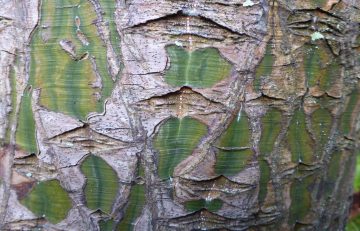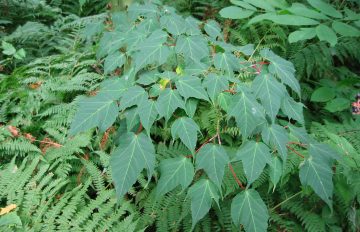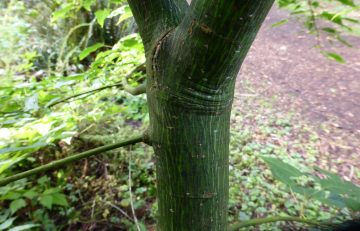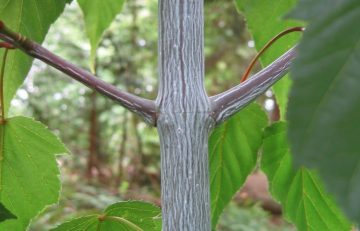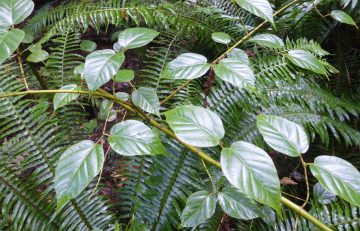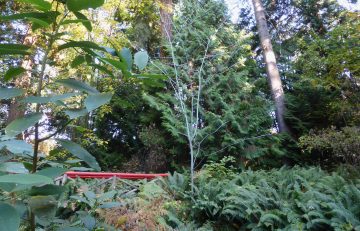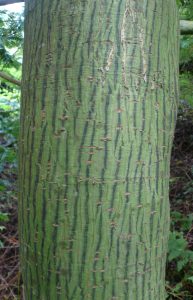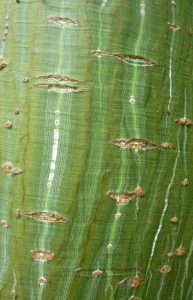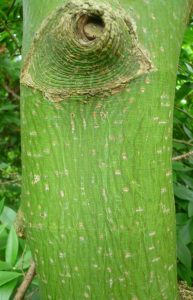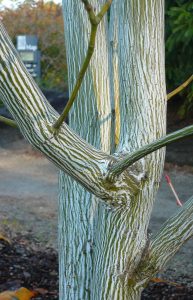January 2025 in the Garden – Year of the Snake (Bark Maple)

Acer capillipes
Maples are usually recognized by their distinctive leaves; thus, winter is generally not a time recommended for their study. But the snake bark maples (also known as stripe-bark maples) are another story. They are among the most beautiful and interesting of all maples, at least at this time of year. The most recognizable feature of the snake barks is their attractive stems. Stem striping is due to waxes that are produced and accumulate in the longitudinal fissures of the expanding bark. While the most common species exhibit strikingly striped stems, not all species in this group do.
Throughout the snake bark group, leaves are often not very maple-like—i.e., in the sense of the “typical” maple leaf shape. They vary from unlobed to three- or five-lobed, mostly with a prominent central lobe. Winter buds are a reliable feature for positive identification of the group, as they are generally large and conspicuously stalked, with a pair of bud scales pressed together along their margins. While some snake barks have plain, brown bark, the majority retain their green, photosynthetic stems for decades, and this allows them to tolerate the lower light of the understorey. In other words, as long as the temperatures are mild, they can manufacture food through photosynthesis, even when leafless. Snake bark maples are also commonly multi-stemmed. The species in this group are adapted to being browsed in the winter (by deer, elk, moose, etc.), and respond to this damage by producing vigorous basal replacement shoots.
UBC Botanical Garden’s collection of snake barks (and maples, generally) is impressive. In total, we have 14 species and a number of selections and hybrids. There is a single North American species, Acer pensylvanicum, which is known as moosewood or striped maple. This species is native around the Great Lakes region and is known to be browsed by—you guessed it—moose, though not exclusively. All other snake barks are Asian. There are several A. pensylvanicum specimens in the Carolinian Forest Garden. Acer tegmentosum (Manchurian striped maple) is remarkably similar in bark and in leaf, despite the great distance between their respective habitats (and I don’t mean the distance between the Carolinian Forest Garden and the David C. Lam Asian Garden!). There is a young tree behind the Campbell Building beside the service road, but our finest example is on Rehder Trail east of the bridge that intersects Fang Trail.
Good examples of Pere David’s maple, Acer davidii, are in the same area. The most widely distributed maple across China, A. davidii is rather variable, including in bark characteristics. Upstream of the bridge is one of Peter Wharton’s collections of this maple (Wharton was the Asian Garden’s first curator). It is a monster of a tree with a combination of dark green bark and corky brown bark closer to the base, but little striping, compared with the group nearby on Hemsley Trail. The smaller Pere David’s maples here were collected (as seed) in China by Asian Garden curator Andy Hill. There are several trees of the same Wharton seed collection scattered around, but the multi-stemmed one on Upper Asian Way west of Maack Trail shows what happens when a single-stemmed snake bark is cut down (the tree was badly damaged in a windstorm) and allowed to regrow. Talk about vigorous! A somewhat different bark effect is seen on the Acer davidii specimen between Fortune and Fang Trails. Here, the striping (now only visible on the younger branches) is red and the overwintering buds pinkish.
Speaking of red, the red-budded snake bark maple, Acer capillipes, is our largest snake bark (in the Azalea Glade on Henry Trail west of Fortune Trail and below Lower Asian Way between Soulie and Flanagan Trails) and the pair are the oldest planted maples in the Garden. On many snake barks, the conspicuous striping on young shoots gradually disappears as the bark becomes increasingly corky with exposure. An intermediate stage between visible stripes and their gradual obliteration by cork is sometimes seen. This has been described as the “diamond bark” pattern and our larger snake barks, including these A. capillipes, often show this pattern. The grey-budded snake bark, Acer rufinerve, is another Japanese species. Here again, our older specimen (on Fang Trail) shows waxy-grey-blue young shoots, striping on the intermediate growth and the diamond-bark pattern on the larger stems. Further to the south in Japan’s Ryukyu Islands is the beautiful Acer morifolium (mulberry leaf maple), a surprisingly cold hardy species, given its warm-temperate to subtropical provenance. With its bright red overwintering buds, one would be forgiven for thinking it just another A. capillipes.
Still further south, in Taiwan, Acer kawakamii (tail-leaf maple) (Kingdon Ward Way near Henry Trail and Upper Asian Way east of Meyer Glade) has exceptional green stems with blue stripes. Acer rubescens, the Taiwan red maple, is a higher elevation species known for its spectacular red autumn colour. The bark is olive green with white stripes. There is a group in the bed below Lower Asian Way east of the lower service road, and a single specimen on Kingdon Ward Way next to the Acer kawakamii.
Two uncommon snake barks, Acer metcalfii (Metcalf’s maple) and Acer sikkimense (Sikkim maple) are more recent arrivals at the Garden. Acer metcalfii (Lower Asian Way south of Farrer Trail) is a southern Chinese snake bark. Although the waxy, bluish stems endowed with prominent stripes suggest Pere David’s maple, the leaves and flower clusters displayed later in the season will not agree with that diagnosis. The rare and somewhat difficult Acer sikkimense (a recent seed collection from the mountains in northern Vietnam), has green unstriped bark, but deep red unfolding leaves in spring. There are no leaves at this time of year—the leaves are spectacularly un-maple-like—but the tree is readily recognized by its stiff stems and strangely perpendicular lateral branches. There is a small specimen on Upper Asian Way east of Tschonoski Trail.
Perhaps the most botanically challenging of the snake barks is the Acer pectinatum complex, an assemblage that represents a group of closely related, intergrading species from Central China to the Himalayas and Vietnam. A number in this group have subtly green-striped young bark that gradually turns green; others have bark that turns brown by the second year. Arguably, the best bark in this group is found on Acer forrestii, and the greenest of ours is on a specimen on Lower Asian Way at Cox Trail. Make sure you run your hands along the impossibly smooth bark of this specimen. While I haven’t provided a complete list of the Garden’s snake bark maples here, consider it a sampler, and an invitation to discover other plants that offer winter interest in UBC Botanical Garden.
- Acer capillipes
- Acer capillipes
- Acer forrestii
- Acer kawakamii
- Acer morifolium ‘Yukawa’
- 1998-0795
- Acer rufinerve
- Acer sikkimense var. ‘serrulatum’
- Acer tegmentosum
- Acer morifolium ‘Yukawa’
- Acer davidii
- Acer forrestii
- Acer pensylvanicum
Written by Douglas Justice
Associate Director, Horticulture and Collections
UBC Botanical Garden & Nitobe Memorial Garden


